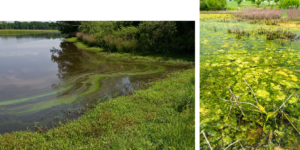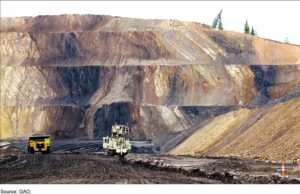February 26, 2024
I posted Obsessed with Phosphorus several years ago. I had done a little research on the element, including the 61-mile long conveyor belt in Western Sahara that can be seen from space. In the Chesapeake Bay watershed, we all know phosphorus as one of the big three pollutants included in the Bay’s pollution diet. Recently, I read Dan Egan’s book, The Devil’s Element – Phosphorus and a World Out of Balance, and realized there is a lot more to mysterious #15 (that’s periodic table talk) than I had known. In fact, “P” could just as easily stand for “paradox” as phosphorus.
The paradox is that, based on Egan’s in-depth research and analysis, we are running out of the stuff but many of our waterways have way too much, with dire consequences for public health and ecosystems.
To say we are running out of phosphorus requires some context. Phosphorus is never very far from us, and is in fact bound up in our bones, teeth, and DNA. It is also instrumental in our metabolism. When living things die, phosphorus is transferred from the living to the non-living world, and on around and around, as it has since the primordial soup days. In other words, phosphorus is a key puzzle piece for life on Earth.
Egan’s “out of balance” phrase in the book’s title refers to human interferences with this ancient cycle, largely as part of the effort to feed a hungry world.
Pure phosphorus (as opposed to the compound phosphate, which exists in some rocks) was brought into our world in less-than-glamorous fashion by 17th century alchemist, Hennig Brandt in Hamburg, Germany. Brandt’s quest for the philosopher’s stone led him to boil and then cook vats of his own urine as well as contributions from friends and family. The “do not try this as home” admonition never rang more true! And this is not only because it was gross, but because the resulting waxy nuggets had an inner glow and were likely to combust in spontaneous fashion.
Brandt named his discovery for the planet Venus (“Bringer of Light), which translates roughly in Latin to “Lucifer,” thus the Devil’s Element part of the book title. At the time, Brandt could not foresee just how devilish this element would become.
As human population grew, agricultural practices needed to keep pace. The pursuit for ways to fertilize crops originated with animal manure, but there came a time where there just wasn’t enough of the stuff. The subsequent search ranged from collecting bones from the battlefield dead (for instance, after the battle of Waterloo) to harvesting bird guano from Peruvian and other Pacific islands, to, ultimately, the discovery of phosphate in certain sedimentary fossil-rich rocks, namely ancient seabed locations where water levels have fluctuated over geologic time. These places include central Florida, Western Sahara, and China, among other spots where today’s phosphate mines are located.
The problem is that, unlike the ancient phosphorus cycle between the living and non-living worlds, the phosphate in rocks won’t replenish itself on any timeframe that makes sense to today’s Earthlings. This, at the same time we desperately need the nutrients for agricultural production and other uses. According to Egan, global phosphate harvesting has quadrupled in just in the last fifty years. Many envision a growing “peak phosphorus” crisis that rivals that of petroleum and fresh water.
There are other sinister parts to this dynamic: the wars, displacement of indigenous populations, and worker health costs of expanding the mining operations. For instance, Western Sahara today (the location of the 61-mile phosphorus conveyor belt) is designated by the U.N. as a “Non-Self-Governing Territory.” Morocco has laid claim to the mine in a decades-old “War of the Sands” with the native Sahrawi people, many of whom have resided in refugee camps in neighboring Algeria for four decades.
Such are the devastating costs of growing our corn, barley, potatoes, rice, rye, wheat, millet, and soy – all of which have historically benefited from Western Sahara’s phosphorus (until a “Blood Phosphorus” campaign put pressure on world governments to ban this source of P).
Egan’s book pivots at its mid-point from these supply-side tales to the role of phosphorus in harmful algal blooms (HABs) occurring with increasing frequency around the world. This is the crux of the “too little – too much” paradox mentioned above.
The culprit is phosphorus-induced blue-green algae, a form of photosynthesizing bacteria known as cyanobacteria, which is also a serious liver toxin. These bacteria are apt to form gooey, stinky bright green mats that are responsible for robbing the water of its oxygen as well as shutting down beaches (and associated beach-dependent businesses) in places like Florida and Lake Erie, contaminating water supplies (Toledo in 2014 is the most notorious example of this), and even killing elephants in Botswana.

Algal blooms are fed by excess phosphorus in waterways Source: U.S. Environmental Protection Agency.
Egan is not kind to modern agriculture – not so much individual farmers, but the system of mandates, incentives, and regulatory reticence induced by policy and industry lobbying.
The book’s storyline is not without hope for the future. Of course, more efficient systems in mining, processing, transporting, and applying phosphorus would help, but the more dramatic solutions lie in re-jiggering our modern wastewater systems. These systems, for essential public reasons, collect, convey, treat, and discharge our wastewater, allowing precious P (double meaning there) to be lost through discharges to waterways that don’t need or want it. However, certain pilot studies at the University of Michigan, Brattleboro, VT, and, Hamburg, Germany (in an ironic nod to the alchemist Hennig Brandt’s hometown) are exploring how to recover phosphorus instead of letting it spill into our waterways. It is from these efforts that we learn that the daily output of a single adult’s urine has enough nutrients to grow enough wheat for an entire loaf of bread.
One thing I enjoyed about this book is that Egan introduces us not only the technical side of phosphorus, but the human stories of people that played key roles in the evolution and understanding of our use of the element. From Hennig Brandt to expert fossil hunter Mary Anning to obsessed limnologist David Schindler, among many others, we get a glimpse into the human dimensions of peculiar circumstances, stumbles and triumphs, and accidental insights that gird the story of the Devil’s Element through the centuries.
So, thanks to Egan, I am even more obsessed with phosphorus, and maybe you should be, too.
The Devil’s Element: – Phosphorus and a World Out of Balance, 2023, Dan Egan, W.W. Norton & Company, Inc. 500 Fifth Avenue, New York, NY 10110.
David J. Hirschman, [email protected]
For those interested in a deeper dive, certainly read Egan’s book and also these previous posts:
Peak Phosphorus and the 61-Mile Long Conveyor Belt (with link to a Planet Money podcast on the subject

